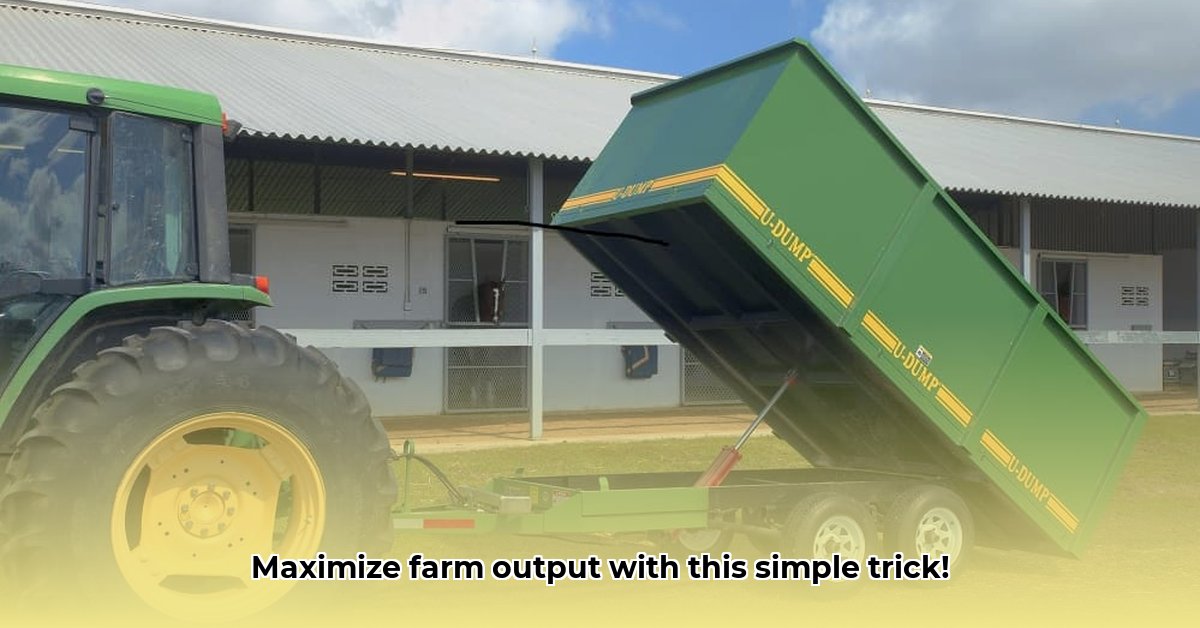
Choosing the Right Dump Cart for Your Sustainable Farm
Selecting the appropriate dump cart significantly impacts farm efficiency and environmental sustainability. This guide helps you choose a cart that optimizes your operations, regardless of farm size. We'll explore factors such as capacity, material, power source, and tire type, ensuring you make an informed decision that benefits both your bottom line and the environment. For more on tractor implements, check out this helpful resource on tractor attachments.
Sizing Up Your Needs: Capacity and Farm Scale
Determining the right dump cart capacity hinges on your farm's size and typical hauling needs. Do you primarily transport small quantities of materials, or will you be moving significant volumes? This will dictate the necessary cubic yard capacity. For example, a small-scale operation might only require a 3-5 cubic yard cart, possibly even manageable manually. Larger farms could need 8 cubic yards or more. Remember, exceeding weight limits can damage equipment and risk injury.
Here’s a comparison to help visualize your needs:
| Cart Capacity (Cubic Yards) | Suitable Farm Size | Tractor Power Recommendation | Typical Uses |
|---|---|---|---|
| 3-5 | Small-scale, Hobby Farms | Small Tractor or Manual Operation | Light hauling, small loads of fertilizer, etc. |
| 6-8 | Mid-sized Farms | Medium-sized Tractor | Larger loads, bulk materials |
| 8+ | Large-scale operations | High-capacity Tractor | Heavy-duty hauling, large-scale operations |
Isn't it crucial to match your cart size to your farm's needs for optimal efficiency? Oversizing can lead to unnecessary expenses and potential soil damage.
Material Matters: Steel, Plastic, and the Environmental Impact
The choice between steel and plastic dump carts involves a trade-off between durability and environmental impact. Steel carts are robust and long-lasting but have a higher carbon footprint during production. Plastic carts are lighter and initially less expensive but may have a shorter lifespan, potentially leading to increased replacement frequency and waste generation.
Consider this: A durable steel cart that lasts for decades could be more environmentally friendly than several plastic replacements, despite the higher initial cost. The most sustainable choice depends on your operational needs and long-term cost analysis. What's the long-term cost of replacement—both financially and environmentally?
Power Play: Manual vs. Tractor-Powered
Manual dump carts reduce fuel costs and reliance on machinery but demand significant physical labor. Tractor-powered carts enhance efficiency for larger volumes but incur fuel expenses and necessitate tractor maintenance. The optimal choice depends on your labor resources, material volumes, and budget.
Consider these factors when choosing your power source:
| Feature | Manual Dump Cart | Tractor-Powered Dump Cart |
|---|---|---|
| Initial Cost | Lower | Higher |
| Labor | High, physically demanding | Low, less physically demanding |
| Fuel Consumption | None | Moderate to High (depending on tractor use) |
| Efficiency | Lower for larger volumes | Higher for larger volumes |
| Maintenance | Lower | Higher (tractor and cart maintenance) |
| Terrain suitability | Good for some, depends on terrain and cart design | Generally good, but may depend on tractor and terrain |
Will investing in a tractor-powered cart reduce long-term labor costs and time constraints?
Tread Lightly: Tire Type and Ground Pressure
Tire selection directly impacts soil compaction. Wider tires distribute weight, minimizing compaction and protecting soil health, which is essential for long-term agricultural sustainability. Pneumatic tires generally offer better ground pressure distribution than solid tires.
Here's a step-by-step approach to minimizing compaction:
- Tire Selection: Opt for wide, low-ground-pressure tires suitable for your soil type.
- Proper Inflation: Maintain the correct tire pressure to avoid over- or under-inflation.
- Avoid Wet Conditions: Postpone work on wet soil.
- Strategic Routing: Plan routes to minimize ground disturbance.
- Soil Health Practices: Incorporate soil-improving practices.
Isn't minimizing soil compaction crucial for preserving the health and productivity of your land?
Safety and Regulatory Compliance: A Priority
Regular maintenance and adherence to safety protocols are paramount. Inspect your cart before each use, addressing any issues promptly. Utilize appropriate safety gear. Familiarize yourself with local regulations governing farm machinery operation. Proactive maintenance and safety practices protect you, your equipment, and the environment.
How much does proactive maintenance contribute to the long-term lifespan and optimal function of your dump cart?
Maintenance and Lifespan: Extending Your Investment
Regular cleaning, lubrication, and prompt repairs extend equipment lifespan, minimizing waste and reducing replacement frequency. This contributes to both financial savings and environmental responsibility. A well-maintained cart is a testament to your commitment to sustainable practices.
Conclusion: Choosing the Right Cart for Long-Term Sustainability
Choosing the right dump cart profoundly impacts farm efficiency and environmental sustainability. Carefully consider factors affecting capacity, materials, power, tires, safety, and maintenance to choose a cart that optimizes your farm's success while promoting responsible land stewardship.
Resources
This section would include links to relevant manufacturer websites, regulatory agencies, and other reputable resources providing further information related to dump cart specifications, safety guidelines, and environmental best practices in agriculture.